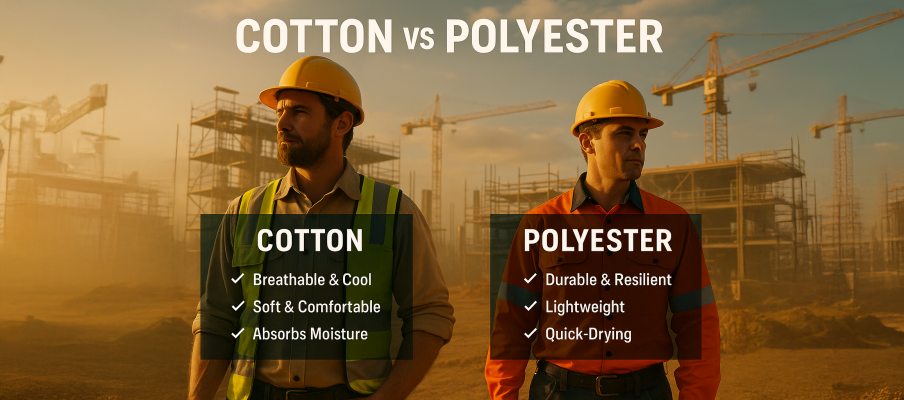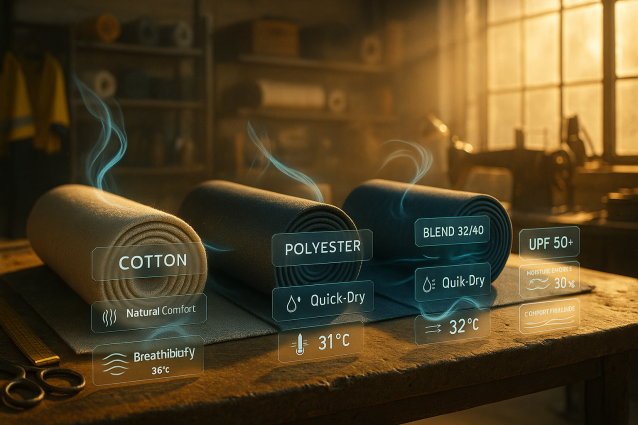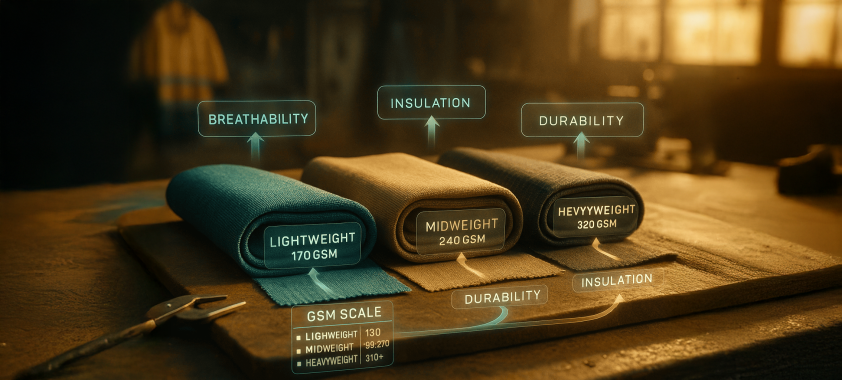Wash in cold water, avoid fabric softeners, and air dry whenever possible. Check reflective tape regularly, rotate shirts to reduce UV fading, and replace garments when compliance labels or tape start to wear off.

Bottom line: For Australian’s hot, dry climate, vented cotton or cotton-poly blends deliver the best balance of comfort and performance.
Choosing between cotton and polyester work shirts comes down to how you balance comfort, durability, and safety under Australia conditions. Here’s what each fabric really offers on-site.
Cotton remains the go-to choice for comfort and airflow. It’s soft, natural, and hypoallergenic, making it perfect for long days in the heat. Cotton’s breathability allows moisture to evaporate, keeping your skin cooler throughout the day.
However, cotton can wrinkle, shrink, and dry slowly, especially in humid environments. For better durability, look for pre-shrunk cotton drill or vented ripstop cotton that combines strength with ventilation.
Polyester stands out for its toughness and low maintenance. It resists stains, wrinkles, and fading, holding colour much longer than cotton. It’s quick-drying and great for jobs that demand constant washing or long wear_
The downside is that polyester can trap heat and retain odours. To improve comfort, choose micromesh or vented polyester blends that boost airflow and reduce heat build-up.
Blended fabrics, like 60% cotton and 40% polyester, combine the softness of cotton with the strength and quick-drying properties of polyester. These blends are easy to care for and ideal for workers who need balance between comfort and durability.

In Western Australia, workwear needs to handle extreme conditions, from 40°C heat to dusty wind and long exposure to UV. Here’s how cotton, polyester, and blends perform when the weather and the job push limits.
Cotton outperforms polyester when it comes to heat control. Its natural fibres allow air to flow and moisture to evaporate, reducing body temperature during long shifts under direct sun. Polyester, being synthetic, traps more heat but dries faster after sweat or rain exposure. Blends strike the middle ground, breathable enough for comfort but durable enough to last through the season.
Polyester wins in abrasion resistance and colour retention. It doesn’t shrink, fade, or weaken easily even after repeated washing. Cotton, while softer and cooler, can wear out faster under mechanical stress or harsh detergents. Ripstop cotton blends are ideal for workers in construction or landscaping, offering extra resistance to tears and stretching.
Polyester dries roughly three times faster than cotton, making it the preferred fabric for humid environments or tradies who sweat heavily. However, cotton remains superior for comfort and odour control, since it doesn’t trap bacteria the way synthetics can. A moisture-wicking blend is the best compromise for long, hot days when you need both dryness and comfort.
Asutralia’s UV levels can exceed 11 in summer — dangerously high. Look for garments marked with AS/NZS 4399 UPF ratings to ensure proper sun protection. Cotton shirts with tight weaves and hi-vis polyester blends with reflective tape both meet compliance, but cotton is more comfortable for full-sun exposure. For ultimate coverage, vented long-sleeve shirts with UPF 50+ are ideal.
Fabric weight, measured in grams per square metre (GSM), plays a key role in how your work shirt feels and performs. It determines breathability, insulation, and overall comfort, which is crucial when you’re working through Australian’s extreme summer heat or cooler months on-site.
For Western Australian conditions, vented ripstop cotton or micromesh blends strike the best balance between toughness, safety, and comfort year-round.

Different roles demand different fabrics. The right choice depends on how much heat, movement, and exposure your job involves. Use this quick guide to find the right fit for your trade and conditions.
| Job Type | Ideal Fabric | Why It Works |
|---|---|---|
| Construction / Outdoor Trades | Cotton or Cotton-Poly Blend | Excellent breathability, high UPF protection, and low static risk — perfect for open-air job sites. |
| Welding / Metal Work | FR Cotton (Flame-Resistant) | Safe near sparks and heat; resists melting and static build-up while staying compliant. |
| Warehouse / Logistics | Polyester or Cotton-Poly Blend | Quick-dry, wrinkle-resistant, and comfortable for high-movement work across mixed environments. |
| Driving / Delivery Work | Cotton-Back Micromesh | Ventilated, odour-resistant, and breathable — keeps drivers cool between stops. |
| Maintenance / Industrial | Midweight Ripstop or Twill | Durable and structured for friction-heavy work. Reinforced against wear and tear. |
| Office or Indoor Technical Roles | Lightweight Cotton or Blend Polo | Smart, easy-care, and comfortable for all-day wear in controlled environments. |
Pro tip: Assess your exposure to heat, sparks, and UV before choosing a shirt. A hi-vis polyester polo may meet standards, but a vented cotton drill shirt will keep you cooler and safer in the Australian sun.

Looking after your work shirts properly extends their lifespan, preserves comfort, and helps maintain compliance (fit, tape visibility, and UPF performance). Follow the care notes below for each fabric type.
There’s no one-size-fits-all answer when it comes to choosing between cotton and polyester work shirts, it’s about finding the right balance for your trade, environment, and comfort level. Cotton keeps you cool and comfortable under the Australian sun, while polyester delivers unmatched durability and easy care. Blends bring the best of both, offering reliable performance for year-round wear.
For outdoor or high-heat work, breathable cotton or flame-resistant options remain the safest and most comfortable choice. If you’re in warehouses, transport, or environments where sweat and constant washing are part of the job, polyester or micromesh blends are more practical. Whatever you choose, make sure your gear meets Australian Standards for safety, sun protection, and visibility.
At The Workers Shop, we don’t just sell workwear, we help Australian tradies choose gear that performs when it counts. Our team understands what it’s like to work in extreme heat, dust, and long shifts.
Stay Cool & Safe This Summer
Not sure what to pick for the heat? Our team will help you choose lightweight shirts, breathable pants and the right safety boots for Australian conditions, all compliant and built for long shifts.
Cotton, cotton-poly blends, and lightweight ripstop are the top performers in WA’s heat. They’re breathable, comfortable, and help regulate body temperature throughout long shifts. For the hottest months, vented cotton drill shirts offer the best airflow and UV protection.
Standard polyester can trap more heat than cotton, but modern moisture-wicking and micromesh blends are designed to draw sweat away from your body and dry quickly. They’re ideal for high-movement or humid environments where comfort and quick-dry performance are essential.
Polyester generally lasts longer. It resists shrinkage, fading, and tearing better than cotton, making it a good choice for tough, high-rotation jobs. Cotton is softer and more breathable but may wear faster in harsh conditions unless it’s a ripstop or blended weave.
Yes — especially in full sun. Long-sleeve cotton shirts provide better protection against UV and heat exposure, while vented panels keep you cool. Many WA tradies prefer lightweight long sleeves for the balance between coverage and comfort.
Wash in cold water, avoid fabric softeners, and air dry whenever possible. Check reflective tape regularly, rotate shirts to reduce UV fading, and replace garments when compliance labels or tape start to wear off.
For jobs involving sparks or heat, flame-resistant cotton is the safest option. Polyester and blends are better suited for general trades, warehouse, or delivery work where quick-dry performance matters more than fire resistance.
Yes. Look for garments marked with AS/NZS 4602.1, 1906.4, and 4399 — these standards cover visibility, reflective tape, and UV protection. Buying compliant workwear ensures your gear is both safe and site-approved.